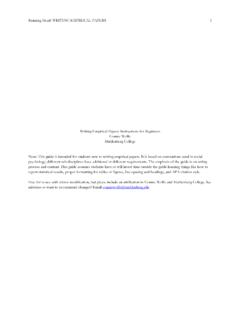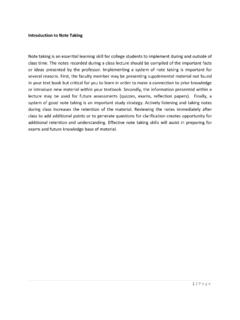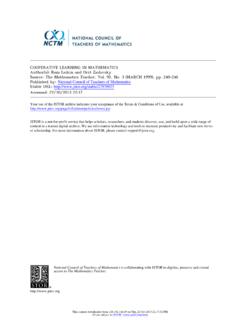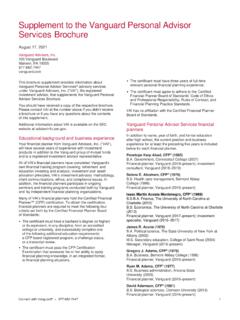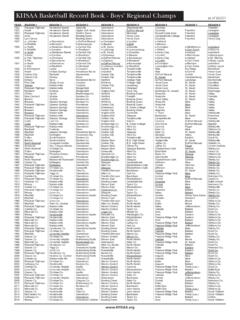Transcription of Writing Analytically
1 Writing Analytically FIFTH EDITION David Rosenwasser muhlenberg college Jill Stephen muhlenberg college THOMSON * WADSWORTH Australia Brazil Mexico Singapore Spain United Kingdom United States THOIVISOIM WADSWORTH Writing Analytically , Fifth Edition David Rosenwasser Jill Stephen Publisher: Lyn Uhl Development Editor: Mary Beth Walden Assistant Editor: Lindsey Veautour Technology Project Manager: Stephanie Gregoire Marketing Manager: Mandee Eckersley Marketing Assistant: Kathleen Remsberg Marketing Communications Manager: Stacev Purviance Senior Content Project Manager: Michael Lepera Senior Art Director: Cate Barr 2009, 2006 Thomson Wadsworth, a part of The Thomson Corporation.
2 Thomson, the Star logo, and Wadsworth are trademarks used herein under license. ALL RIGHTS RESERVED. No part of this work covered by the copyright hereon may be reproduced or used in any form or by any means graphic, electronic, or mechanical, including photocopying, recording, taping, Web distribution, information storage and retrieval systems, or in any other manner without the written permission of the publisher. Print Buyer: Mary Beth Hennebury Text Permissions Editor: Mardell Glinski Schultz Photo Permissions Editor: Sheri Blaney Production Service: Graphic World Publishing Services Text Designer: John Ritland Compositor: Graphic World Inc.
3 Cover Designer: Maxine Ressler Cover Image: Thinkstock/RF/Ron Chappie/ Jupiter Images Thomson Higher Education 25 Thomson Place Boston, MA 02210 USA For more information about our products, contact us at: Thomson Learning Academic Resource Center 1-800-423-0563 For permission to use material from this text or product, submit a request online at Anv additional questions about permissions can be submitted by e-mail to Printed in Canada 12 3 4 5 6 7 11 10 09 08 07 Library of Congress Control Number: 2007939138 ISBN-13: 978-1-413-03310-6 ISBN-10: 1-413-03310-5 BRIEF CONTENTS UNIT I THE ANALYTICAL FRAME OF MIND: INTRODUCTION TO ANALYTICAL METHODS 1 CHAPTER 1 Analysis: What It Is and What It Does 3 CHAPTER 2 Counterproductive Habits of Mind 17 CHAPTER 3 A Toolkit of Analytical Methods 31 CHAPTER 4 Interpretation.
4 What It Is, What It Isn't, and How to Do It 49 CHAPTER 5 Analyzing Arguments 73 CHAPTER 6 Topics and Modes of Analysis 93 UNIT II WRITINGTHE ANALYTICAL ESSAY 107 CHAPTER 7 What Evidence Is and How It Works 109 CHAPTER 8 Using Evidence to Build a Paper: 10 on 1 versus 1 on 10 123 CHAPTER 9 Making a Thesis Evolve 139 CHAPTER 10 Structuring the Paper: Forms and Formats 159 CHAPTER 11 Introductions and Conclusions 179 CHAPTER 12 Recognizing and Fixing Weak Thesis Statements 193 V Brief Contents UMTII WRITINGTHE RESEARCHED PAPER 203 CHAPTER 13 Reading Analytically 205 Using Sources Analytically : The Conversation Model 215 CR PTER 15 Organizing and Revising the Research Paper: Two Sample Essays 227 ftPTER 16 Finding, Citing, and Integrating Sources 241 UNIT IV GRAMMAR AND STYLE 269 Style.
5 Choosing Words for Precision, Accuracy, and Tone 271 HAPTER 18 Style: Shaping Sentences for Precision and Emphasis 287 HAPTER 19 Common Grammatical Errors and How to Fix Them 305 CONTENTS Preface xvii UNIT I -THE ANALYTICAL FRAME OF MIND: INTRODUCTIONS) ANALYTICAL METHODS 1 CHAPTER l Analysis: What It Is and What It Does 3 First Principles 3 Analysis Defined 3 The Five Analytical Moves 4 Move 1: Suspend Judgment 5 Move 2: Define Significant Parts and How They're Related 5 Move 3: Make the Implicit Explicit 6 Move 4: Look for Patterns 8 Move 5: Keep Reformulating Questions and Explanations 9 Analysis at Work: A Sample Paper 10 Distinguishing Analysis from Argument, Summary, and Expressive Writing 11 Applying the Five Analytical Moves.
6 The Example of Whistler's Mother 13 Analysis and Personal Associations 15 CHAPTER 2 Counterproductive Habits of Mind 17 Fear of Uncertainty 17 Prejudging 18 Blinded by Habit 19 The Judgment Reflex 20 Generalizing 21 Overpersonalizing (Naturalizing Our Assumptions) 23 Opinions (versus Ideas) 25 What It Means to Have an Idea 26 Rules of Thumb for Handling Complexity 28 vii viii Contents CHAPTER 3 A Toolkit of Analytical Methods 31 The Toolkit 32 Paraphrase X 3 33 Notice and Focus (Ranking) 35 Prompts: Interesting and Strange 35 10 on 1 36 The Method: Working with Patterns of Repetition and Contrast Thinking Recursively with Strands and Binaries 39 Generating Ideas with The Method: An Example 40 Doing The Method on a Poem.
7 Our Analysis 40 A Procedure for Finding and Querying Binaries 43 Freewriting 44 Passage-Based Focused Freewriting 45 Writers' Notebooks 46 Passage-Based Focused Freewriting: An Example 47 CHAPTER 4 Interpretation: What It Is, What It Isn't, and How to Do It 49 Pushing Observations to Conclusions: Asking So What? 50 Asking So What?: An Example 51 Implications versus Hidden Meanings 54 The Limits on Interpretation 56 Plausible versus Implausible Interpretations 57 Interpretive Contexts and Multiple Meanings 58 Specifying an Interpretive Context: An Example 58 Intention as an Interpretive Context 59 What Is and Isn't "Meant" to Be Analyzed 60 The Fortune Cookie School of Interpretation 61 The Anything Goes School of Interpretation 62 Seems to Be about X but Could Also Be (Is Really) about Y 63 Putting It All Together.
8 Interpretation of a New Yorker Cover 65 Description of a New Yorker Cover, Dated October 9,2000 65 Using The Method to Identify Patterns of Repetition and Contrast 67 Contents ix Pushing Observations to Conclusions: Selecting an Interpretive Context 68 Making the Interpretation Plausible 69 Arriving at an Interpretive Conclusion: Making Choices 70 CHAPTER 5 Analyzing Arguments 73 The Role of Binaries in Argument 73 A Procedure for Reformulating Binaries in Argument 74 Strategy 1: Locate a Range of Opposing Categories 74 Strategy 2: Analyze and Define the Key Terms 74 Strategy 3: Question the Accuracy of the Binary 75 Strategy 4: Substitute "To What Extent?
9 " for "Either/Or" 75 Uncovering Assumptions (Reasoning Back to Premises) 76 Uncovering Assumptions: A Brief Example 78 A Procedure for Uncovering Assumptions 78 Analyzing an Argument: The Example of "Playing by the Antioch Rules" 79 Strategies for Developing an Argument by Reasoning Back to Premises 82 The Problems with Debate-Style Argument 84 Seeing the Trees as Well as the Forest: Toulmin and the Rules of Argument 85 Refining Categorical Thinking: Two Examples 88 A Brief Glossary of Common Logical Errors 90 CHAPTER 6 Topics and Modes of Analysis 93 Rhetorical Analysis 93 Rhetorical Analysis of a Place: A Brief Example 94 Rhetorical Analysis of an Advertisement: A Student Paper 94 Summary 96 Strategies for Making Summaries More Analytical 96 Personal Response.
10 The Reaction Paper 98 Strategies for Making Personal Responses More Analytical 98 Agree/Disagree 100 Comparison/Contrast 100 Strategies for Making Comparison/Contrast More Analytical 100 x Contents Definition 102 Strategies for Making Definition More Analytical 102 UNIT If Writing THE ANALYTICAL ESSAY 107 CHAPTER 7 What Evidence Is and How It Works 109 The Function of Evidence 110 The Missing Connection: Linking Evidence and Claims 110 "Because I Say So": Unsubstantiated Claims 111 Distinguishing Evidence from Claims 111 Giving Evidence a Point: Making Details Speak 112 How to Make Details Speak: A Brief Example 113 What Counts as Evidence?
